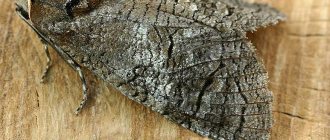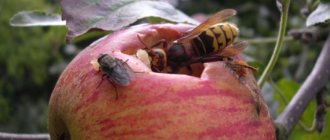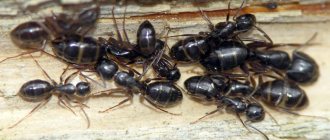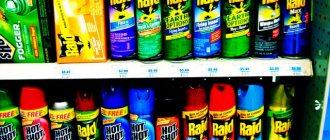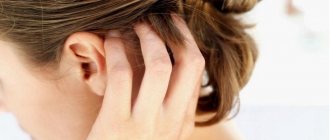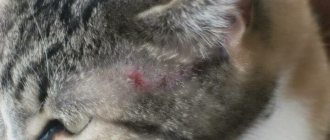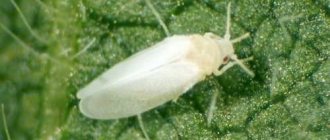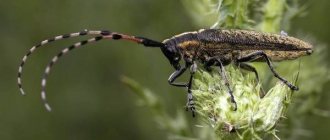Longhorn beetles or woodcutters are one of the most numerous families of beetles. Their characteristic feature is the presence of segmented whiskers, longer than the size of the insect’s body. The black spruce longhorned beetle is a small beetle that lives in coniferous forests. It belongs to the biological group of forest pests. Adults eat young tree branches, and the larvae gnaw through numerous tunnels in them. From their impact, living trees die, and lumber loses quality and becomes unsuitable for construction work.
Botanical description of the species
The black spruce longhorned beetle is a species belonging to the genus of black longhorned beetles (Monochamus). The imago is characterized by an elongated, dark-colored body. The head is large, the mandibles (jaws) are well developed. The antennae are thin, long, and consist of many segments. The elytra are slightly narrowed towards the end. They are usually rounded, without sharp protrusions or thorns. The forelegs of males are significantly longer than the hind legs.
Information. The way of life associated with trees gave the longhorned beetles their second name - lumberjacks.
Spruce longhorned beetles come in two types:
- The small black spruce beetle (Monochamus sutor) is a coleopteran insect measuring 14-28 mm. The body is flat, the elytra are cylindrical. The mustache of males exceeds the body length by 2.5 times, and that of females by 1.5 times. The scutellum is divided by a smooth stripe. Life cycle is two years. The favorite food plant of the larvae is Norway spruce. Adult years are from June to September. The larva is large, white, with strong jaws. Her head is recessed into the prothorax. The length of the larva is 35-40 mm. A distinctive feature of the species is the choice of trees in open areas and on southern slopes. It settles on felled wood and lumber in well-lit places. Insects cause significant physiological and technical damage.
- The large black spruce longhorned beetle (Monochamus sartor) is slightly larger than its close relative. Its body length is 15-37 mm. The flattened body has a slight brown tint. The female and male can be distinguished visually. In males, there is a transverse indentation on the elytra, covered with a greenish dotted line. Females have white and yellow hairy spots on the elytra. The length of the mustache is another characteristic indicator. In males they are twice as long as the body, and in females they protrude slightly behind the elytra. The length of the larva is 55 mm. Beetles choose mountainous terrain, clearings and windbreaks for their habitat.
Parasitic organisms
Black longhorned beetles are often parasitized by nematodes. Before the imago emerges from the pupa, the worms settle on the external and internal organs of the beetles, mainly concentrating in the area of the spiracles.
Harm and ways to combat it
The food for the beetle is coniferous trees, especially pine and spruce. This served to introduce the insect into the biological group. During maturation, longhorned beetles gnaw at the bark of the pine tree. The larvae destroy wood, bast and sapwood. The result of the life activity of the black pine longhorned beetle is the weakening and subsequent drying out of the tree. The larvae damage untreated wood, reduce its technical suitability, and thereby undermine forestry. Biological methods of exterminating beetles include attracting birds that feed on insects.
According to sanitary rules, the following control methods exist:
- timely implementation of selective and clear cuttings;
- immediate cleaning of the places where the work was carried out, namely the removal and debarking of the material;
- systematic sampling of fallen and dead forests.
This type of insect lives in European countries: from Switzerland, France, the northern regions of Italy and Romania to Ukraine. The beetle can be found in coniferous areas. They prefer to live in mountains, windbreaks and clearings. Adult longhorned beetles feed on the roots and bast of young branches of spruce, pine, fir and other coniferous trees. Arthropod activity continues from the second part of June to September.
The body of the spruce longhorned beetle has the shape of a black cylinder, the length of which in a mature state is 15-37 mm. On the elytra of females you can see light spots where hairs grow. There is a sharp tubercle on the pronotum. The apices of the elytra are not characterized by dense hairy pubescence. The scutellum is strewn with bristles, including the midline. The female's antennae curl slightly behind the elytra and have light rings. In the male they are twice the length of his body.
Life cycle
The development of the beetle takes 2 years, and in unfavorable conditions it can take 3 years. The first longhorned beetles appear in May, but the main years are in June. Before laying eggs, they require additional nutrition on young twigs and needles. The fertilized female makes incisions in the bark, into which she lays white oblong eggs. Young larvae begin constructing tunnels in the bark. By autumn they go deeper into the tree trunk. The larva is white, legless, moves with the help of warts on the first 7 abdominal segments. In a special recess covered with sawdust, the larva pupates. The young beetle climbs out of the trunk through a hole in the bark.
Lesser black spruce beetle (Monochamus suto)
While not competing with the black pine longhorned beetle, the small black spruce longhorned beetle operates in the coniferous forests of the European part of the country and Siberia. The almost cylindrical wings of the insect are painted black or brown, have a glossy sheen, and long antennae are often several times the size of the body. The average length of an adult insect is 14 – 28 mm, and the larvae are 30 – 45 mm.
The pest prefers mixed and coniferous forests, in which it chooses spruce, fir or larch, and sometimes pine.
The active summer of beetles occurs in June–July. First, young insects gain strength by eating bark from young branches of coniferous trees, after which mating occurs, and the fertilized female lays a pair of eggs under the bark. The insect gnaws holes for eggs on its own, or uses cracks in the bark for this purpose. Larvae emerge from the eggs, which initially feed on the subcortical layer, gradually moving deeper into the trunk closer to autumn. Like the large pine longhorned beetle, the small spruce longhorned beetle is a dangerous technical wood pest.
- Deep staple-like passages of larvae (deep wormholes) greatly reduce the quality of wood, making it unsuitable for basic types of construction work.
- A massive population of pests infects not only weakened trees, but also healthy, strong trees.
- Insects are pests not only of living trees; eggs can be laid in unbarked timber.
Larval passages
Measures to combat the small spruce black longhorned beetle are the same as in the case of a forest infested with a large pine longhorned beetle.
Related species Monochamus urussovi
The Eurasian species of longhorned beetle is similar in appearance to its counterparts living on spruce. The beetles live on trees of the pine family, but prefer fir trees. The species is widespread in dark coniferous forests of Russia, northern Asia and Europe. The eastern border of distribution reaches Korea and Japan. The black fir longhorned beetle reaches sizes of 18-37 mm. The body, legs and antennae are black. Females have white hairs on their elytra. It differs from other members of the family in several ways:
- depressed groove at the end of the elytra;
- light hairs on the apex of the elytra;
- granular punctation of the base of the elytra;
- grainy antennae of the male.
The larvae of the spruce and fir black longhorned beetles are similar to each other. They gnaw deep passages and throw sawdust out through the holes.
Insect development at all stages
Embryo formation lasts 13-29 days. By mid-July, the eggs have time to turn into larvae. They feed on the bark, thereby moving towards the woody layers. After 25-45 days, the larvae are already quite deep in the tree. In this case, plants often crawl into the subbark area and eat sapwood and bast. At this time, dust accumulates in the damaged trunk. The larvae overwinter in tree holes, which do not reach the surface by 1-1.5 cm.
Pupation occurs in 15-25 days. An adult black pine longhorned beetle gnaws a flight hole in a tree and emerges. Pests settle in trees that are weakened for some reason, fresh windfalls and cut trunks. The beetle uses them as housing and gnaws those viable pines that grow in steppe forests. It has been noticed that the black pine longhorned beetle, the photo of which is posted in this article, does not reproduce and does not settle in stumps.
Malicious actions and countermeasures
Changeable weather conditions, disasters and cataclysms make it impossible to regulate the number of harmful beetles. Large and small spruce longhorned beetles thrive in areas that have suffered a fire or attack by Siberian silkworm caterpillars. Among the measures that can reduce the number of harmful insects are the following:
- The use of natural enemies of woodcutting beetles - birds (woodpeckers, swallows).
- Timely sanitary felling of weak trees.
- Preparation of trap trees - special spruce or fir trunks to which the larvae are attracted and then destroyed before they are buried in the wood.
- When a forest area is heavily infested, insecticides are used to help destroy insect pests.
- Fast processing and proper storage of lumber. Unrooted trunks should not be left in clearings for a long time.
Attention. As a preventative measure, wood and freight vehicles are chemically treated.
Harm from woodcutter beetles
In addition to personal destruction of the forest, beetles are distributors of wood nematodes. These are parasitic plant-eating worms. They feed on tree sap, causing yellowing of needles and death of branches and trunk. Annual losses of timber amount to millions of cubic meters.
Attention. The large black spruce longhorned beetle is classified as a quarantine species.
The presence of dangerous beetles can be determined by their characteristic features: notches, drill flour, larvae. If you notice insects, you must report them to the pest control service.
Black pine longhorned beetle (Monochamus galloprovincialis)
This species of beetle is widespread in the European part of Russia, Siberia and the Far East, and is listed as a quarantine pest. The body length of the insect is 11 – 28 mm, the body is elongated on the underside and covered with a yellowish cover. The color of the wings is brown or black, a distinctive feature is a bronze tint and the presence of several white spots, asymmetrically located across the back. For food it prefers pine trees, usually found in forest and steppe forests, where it inhabits pine, sometimes spruce, cedar and larch.
Coniferous wood is food for adult insects and larvae. Development from larva to adult in the middle zone lasts one year, in the northern regions the generation lasts two years.
Adult insects gnaw the bark of young pine trees. After fertilization, females gnaw a small funnel up to 2 mm deep in the trunk, where they lay 1–2 eggs. During the flight season, each female can lay up to thirty eggs. Each larva that emerges from the egg first gnaws a small area at the site of the notch, and then begins to move deeper into the trunk, feeding on bast, sapwood and wood. Over the course of a year, the larva gnaws a staple-shaped passage, the length of which does not exceed 30 cm. In the spring it pupates and by summer turns into a young insect, gnaws a small round hole in the wood and emerges.
Harm caused to humans:
Measures to combat black pine longhorned beetle:
- Attracting their natural enemies - insectivorous birds (woodpeckers, swallows and others) to the area infested with longhorned beetles.
- Elimination of any pests that weaken the trees.
- Sanitary felling of dead trees (carried out in winter) and treatment of diseased trees.
- If the number of insects is high, trees are sprayed with insecticides.
- Preparing trap trees for pests, debark trap trees and destroy the larvae before they go deep into the wood.
- Timely cleaning of logging areas from waste. Insects often inhabit windbreaks, remnants of timber, and discarded timber.
- Fast and correct processing and storage of timber.
Black large pine beetle (Monochamus urussovi Fisch)
Black coniferous longhorned beetles of this genus have large body sizes, which are always more or less elongated. It is most often shiny, black or pitch black. The elytra are long, in most cases strongly elongated, slightly tapering towards the end, usually rounded, with rough sculpture and dense, lighter hairs. The antennae are more or less thin, 1.5 times longer than the body, with one segment strongly thickened.
The larvae are white, legless, the head is black, the body is somewhat narrowed towards the end, covered with short, sparse bristles. The sternites of the mesothorax and metathorax are granulated by two rows of granules. The abdomen has calluses on segments 1–7; they are distinctly granular and covered with microscopic spines. The size of the larvae depends on the species and reaches 4–6 cm in the fir longhorn beetle. The larvae first gnaw out large, irregularly shaped areas under the bark, and then delve into the wood, where they make very large staple-like passages. Thus, the fir barbel has a vertical stroke length of 15 cm, a total stroke length of 30–40 cm. The flight opening is 1–1.2 cm.
All black longhorned beetles undergo additional feeding in the crowns of trees, damaging shoots and branches. Black coniferous longhorned beetles cause extremely great harm, rendering the wood completely unusable. The yield of industrial wood from tree trunks damaged by longhorn beetles does not exceed 27%. Black coniferous longhorned beetles are constant companions of the most terrible pest of taiga forests - the Siberian silkworm. They also reproduce in areas of root sponge, pine silkworm and other pine-eating insects, being pests not only of wood, but also of growing forests.
Protection measures: Attracting insectivorous birds, especially woodpeckers, to the plantings. Destruction of sucking pests, whose activity weakens trees. Timely removal of non-viable trees that dry out and replacing them with young ones. In case of dangerous numbers of longhorned beetles, spray trees with insecticides when the beetles emerge.
